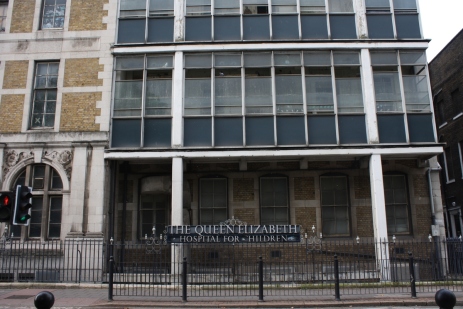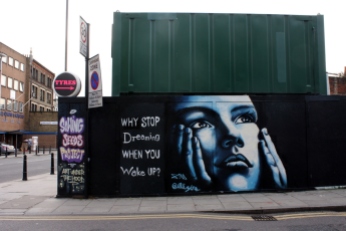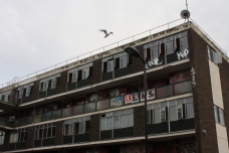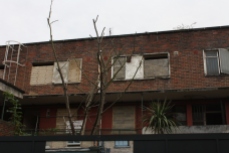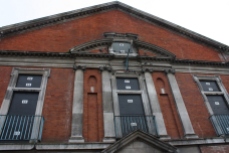Does property serve a social function? You might think the answer is “yes, of course”. The purpose of a house, for example, is to house people, to serve as a space in which to create a home. These days, though, it seems that houses are more often used as a financial good rather than to serve a direct use like that of providing shelter. This is evident in the vast international system by which land and property are bought and sold according to the supply and demand of the “property market”. In many national contexts, you cannot really be secure in your housing situation until you own your own house. This in many ways dictates patterns of urban development: people will buy or rent property in areas where the property value is low enough that they can afford; meanwhile, wealthy developers have every right to buy up property and profit off of it as they see fit—after all, they paid for it.
But this is not an inevitable process; in fact, it reflects only one interpretation of what we call “property”, one that fulfills a trajectory of urbanization that seems near impossible to challenge. It is therefore not surprising that the concept of the “social function of property” whereby property must fulfill a social function and cannot merely be used for profit, is increasingly taken up by social movements fighting for the rights to land and housing around the world.[1]
São Paulo is one city where the contradictions of the “property market” are especially apparent, and groups contesting the situation particularly active. The housing deficit is currently estimated to be at 230,000 homes.[2] Meanwhile, there are hundreds of vacant buildings in the city center. In response to this, dozens of sem-teto or “roofless” movements have formed, demanding the right to secure housing and undertaking occupations of vacant buildings to draw attention to the housing crisis. These occupations not only highlight the current urban reality of unequal property ownership, but also put into question the very concept of property.
The private ownership model of property
In his work Unsettling the City, Nicholas Blomley highlights the hegemony of what he calls the “ownership model” of property, where there is generally one definable owner to a clearly delineated piece of land, and property almost exclusively means private property. Private property indicates a certain form of power that seems to have “an independent, nonstatelike quality”, as the idea that someone can exclusively claim a parcel of space is taken for granted.[3] This model came to dictate what kind of property we are supposed to value–i.e., private, owner-occupied, etc.–which in turn raises the overall perceived value of this kind of property, in a process seen as uncontestably determined by “the market”. But only those who are able to buy into this market get the right to property.
People did not always conceive of property in this manner. This particular understanding of property arose to prominence out of a desire to provide order to the city, beginning with the colonization of land. Indigenous groups did not usually conceive of property in the same way as their colonizers, and so a new, more regulated, interpretation of property was necessary in order to physically “settle” the land: “the colonization of land, the physical substance, could not have proceeded without the simultaneous colonization of property, the mental structure for organizing rights to land.”[4] Adrian Blackwell describes how this ownership model then enabled property to be carefully partitioned and therefore easily exchanged in a capitalist market:
The secret of capitalist property lies in the way in which the most grounded and immobile of things—land—can be made to move through its financialization and exchange-ability, while this same property is rendered absolutely solid, reified, as each absentee owner decides who can and cannot enter it.[5]
Thus property has come to be viewed as a parceled good to be bought and sold. Brazilian scholar and planner Raquel Rolnik argues that housing is viewed increasingly as an investment asset in a globalized financial market, rather than as a social good. She explains how, rather than a means to distribute wealth, housing has become a “means to wealth”, where “the value is the possibility of creating more value, which depends on the speed and number of transactions capable of generating value appreciation”. While ideas of housing as commodity confronted various national welfare models in different national contexts, many governments around the world have mobilized a range of policies to “extend market discipline, competition and commodification”.[6] The result has been urban enclaves created for the wealthy and international elite, with the poor confined to peripheral areas (or, in the North American case, “inner city” areas), often with limited basic services and employment opportunities.[7] Clearly in Brazil as elsewhere, this has meant the growth of informal settlements, forming part of an agenda which Rolnik asserts is “to create an urban scenario where the poor don’t exist and at the same time ‘unlock’ the value of land”.[8]
Viewing property and the real estate market as natural and self-evident has a de-politicizing effect. It masks the actors and social processes involved in deciding the “value” and accessibility of property. It assumes that the value of property lies only in its exchange value, and that this value is to be decided by the “market”. It makes it very difficult to imagine that property could be understood in any other way.



 If you live in the UK, please sign the petition:
If you live in the UK, please sign the petition: 









